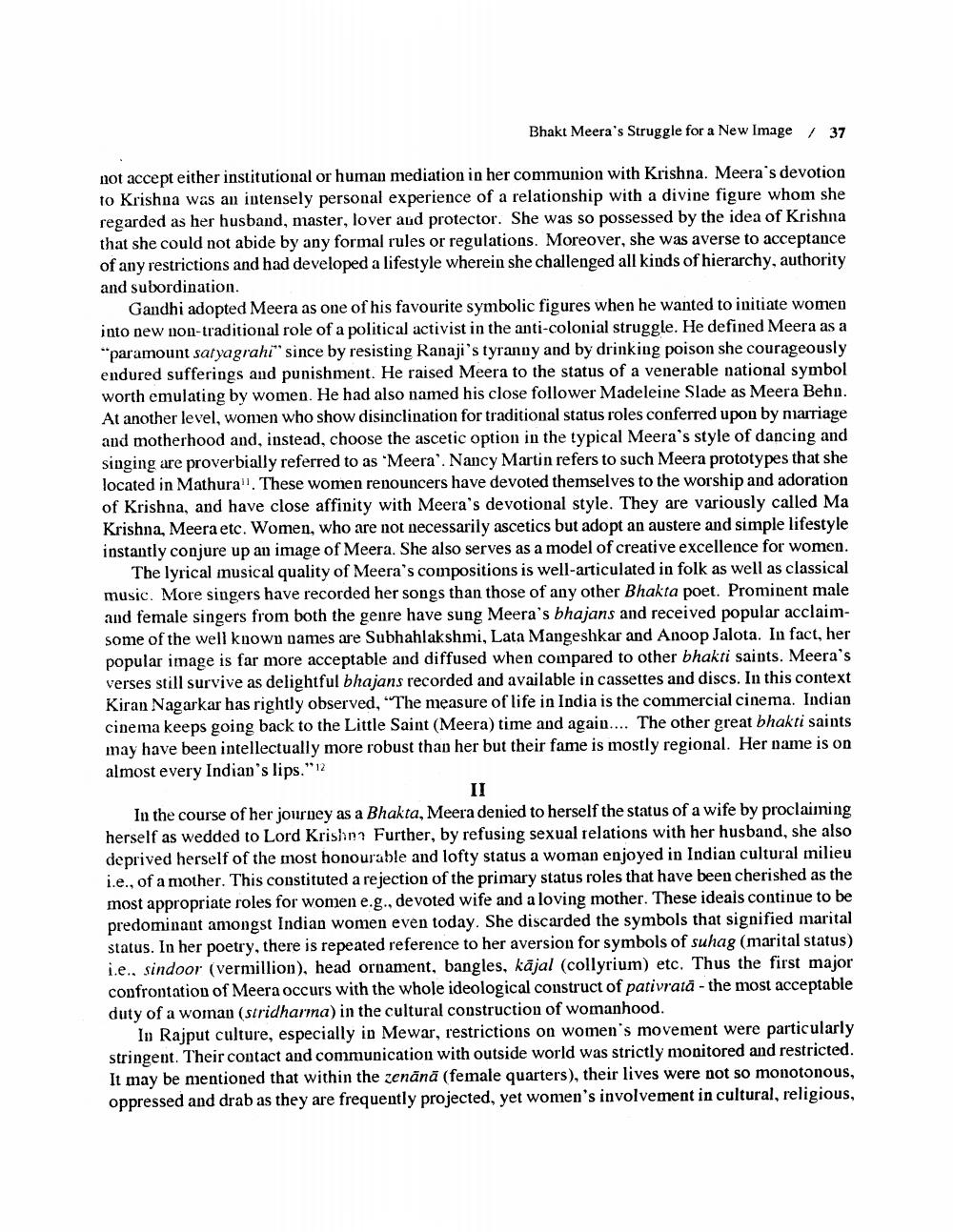________________
Bhakt Meera's Struggle for a New Image / 37
not accept either institutional or human mediation in her communion with Krishna. Meera's devotion to Krishna was an intensely personal experience of a relationship with a divine figure whom she regarded as her husband, master, lover and protector. She was so possessed by the idea of Krishna that she could not abide by any formal rules or regulations. Moreover, she was averse to acceptance of any restrictions and had developed a lifestyle wherein she challenged all kinds of hierarchy, authority and subordination.
Gandhi adopted Meera as one of his favourite symbolic figures when he wanted to initiate women into new non-traditional role of a political activist in the anti-colonial struggle. He defined Meera as a "paramount satyagrahi" since by resisting Ranaji's tyranny and by drinking poison she courageously endured sufferings and punishment. He raised Meera to the status of a venerable national symbol worth emulating by women. He had also named his close follower Madeleine Slade as Meera Behn. At another level, women who show disinclination for traditional status roles conferred upon by marriage and motherhood and, instead, choose the ascetic option in the typical Meera's style of dancing and singing are proverbially referred to as 'Meera'. Nancy Martin refers to such Meera prototypes that she located in Mathura". These women renouncers have devoted themselves to the worship and adoration of Krishna, and have close affinity with Meera's devotional style. They are variously called Ma Krishna, Meera etc. Women, who are not necessarily ascetics but adopt an austere and simple lifestyle instantly conjure up an image of Meera. She also serves as a model of creative excellence for women.
The lyrical musical quality of Meera's compositions is well-articulated in folk as well as classical music. More singers have recorded her songs than those of any other Bhakta poet. Prominent male and female singers from both the genre have sung Meera's bhajans and received popular acclaimsome of the well known names are Subhahlakshmi, Lata Mangeshkar and Anoop Jalota. In fact, her popular image is far more acceptable and diffused when compared to other bhakti saints. Meera's verses still survive as delightful bhajans recorded and available in cassettes and discs. In this context Kiran Nagarkar has rightly observed, "The measure of life in India is the commercial cinema. Indian cinema keeps going back to the Little Saint (Meera) time and again.... The other great bhakti saints may have been intellectually more robust than her but their fame is mostly regional. Her name is on almost every Indian's lips."12
II
In the course of her journey as a Bhakta, Meera denied to herself the status of a wife by proclaiming herself as wedded to Lord Krishna Further, by refusing sexual relations with her husband, she also deprived herself of the most honourable and lofty status a woman enjoyed in Indian cultural milieu i.e., of a mother. This constituted a rejection of the primary status roles that have been cherished as the most appropriate roles for women e.g., devoted wife and a loving mother. These ideals continue to be predominant amongst Indian women even today. She discarded the symbols that signified marital status. In her poetry, there is repeated reference to her aversion for symbols of suhag (marital status) i.e.. sindoor (vermillion), head ornament, bangles, kajal (collyrium) etc. Thus the first major confrontation of Meera occurs with the whole ideological construct of pativrată - the most acceptable duty of a woman (stridharma) in the cultural construction of womanhood.
In Rajput culture, especially in Mewar, restrictions on women's movement were particularly stringent. Their contact and communication with outside world was strictly monitored and restricted. It may be mentioned that within the zenänä (female quarters), their lives were not so monotonous, oppressed and drab as they are frequently projected, yet women's involvement in cultural, religious,




